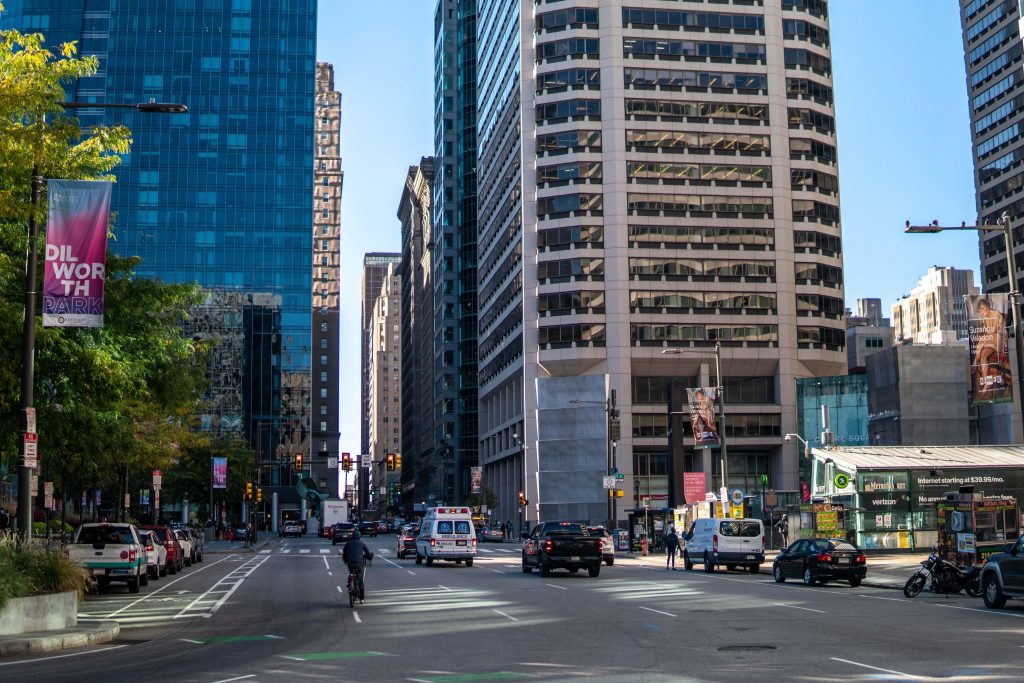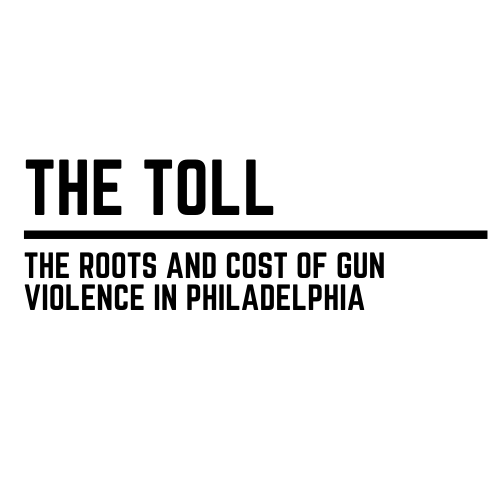At the Anti-Violence Partnership of Philadelphia, a harm reduction service, the waitlist for counseling services is currently the longest it has ever been, limiting their ability to efficiently offer services to domestic violence survivors.
“We are at capacity and we can refer you to one of our partners and they’re at capacity,” said Emily DeCarlo, the program director of Youth Violence Outreach at the Anti-Violence Partnership of Philadelphia on Hamilton Street near N. 20th.
At AVP, the 400 people on the waitlist are expected to wait between 10 to 12 months to receive counseling services, DeCarlo said.
Following a surge of overall violence in the city, some domestic violence service providers adjusted their operations and requested more support from city leadership, viewing the increase as a symptom of a wider epidemic.
Both gun violence and domestic violence have risen steadily since the COVID-19 pandemic began because isolation intensifies instances of domestic violence, said Katie Young-Wildes, the senior communications specialist at Women Against Abuse, a non-profit domestic violence advocacy service located at Broad Street near Sansom.
Stay-at-home orders and remote work during the pandemic led many people to spend an excess amount of time inside their homes, which can be an added risk to those that live with an abuser, Young-Wildes added.
While organizations like AVP provide domestic violence support, there are four resource centers in Philadelphia, all funded by the city, with the sole purpose of assisting those experiencing this form of violence.
Although there are only four, these resource centers work in close collaboration with each other and city agencies. For example, Shared Safety, a coordinated community response to violence, consists of 70 agencies citywide that work together to ensure survivors receive adequate support, said Whitney Brown, policy associate at WAA.
The Philadelphia Police Department responds to more than 100,000 calls related to domestic violence annually, according to WAA.

Yet, there is a notable amount of cases that go unreported, said Lindsay Cloud, the director of the Policy Surveillance Program of the Center for Public Health Law Research at Beasley School of Law.
For Lisa Christian, the director of Counseling Services at AVP, being unable to remove people from the waitlist for services in a timely manner has been a challenging aspect of her position.
“That is very problematic because we know people are hurting and we know that people need support and not being able to give it to them when they reach out is very difficult,” Christian said.
While there are many organizations working to help those experiencing domestic violence, they often cannot relocate or provide ongoing services to survivors because they lack resources and funding to efficiently complete their work, said Adara Combs, head of the Office of the Victim Advocate, a supporter for victims of crime in Philadelphia.
THE EMERGENCE OF GUN VIOLENCE IN PHILADELPHIA
The United States is overpopulated with guns, making its domestic violence rates even more lethal, said Jerry Ratcliffe, a criminal justice professor at Temple University.
Four in 10 adults say they live in a household with a gun, including 30 percent who say they personally own one, and gun sales have only risen due to the pandemic, according to a 2021 survey by Pew Research Center.
In the third week of December 2020, during a spike in gun assaults nationwide, Philadelphia was the city with the highest rate, according to the Council on Criminal Justice.
Even after this spike, gun violence rates remained relatively high this past year.
“We’re seeing unprecedented levels of gun violence plaguing our streets and neighborhoods right now and then we’re also seeing a doubling of domestic violence homicides, so it’s a really troubling scenario and one that really needs to be addressed.” Young-Wildes said.
While violence has been further exacerbated by conditions of the pandemic, like social isolation and economic distress, the city also has a history that creates a racial divide in experienced gun violence.
The neighborhood blocks responsible for the lion’s share of Philadelphia’s gun violence were heavily redlined in the 1930s, creating “a long-term linkage” between the discriminatory lending program and the gunfire that directly impacts Black and brown communities, The Philadelphia Inquirer reported.
Nearly 95 percent of shooting victims were people of color, and Black men comprised three-quarters of both shooting fatalities and total victims in 2021, Billy Penn reported.
These patterns of racial disparities in experienced violence are also present in domestic violence.
“In America, in particular, there is a very unique and deadly relationship between firearms and intimate partner violence, especially for women, and especially for Black women,” Cloud said.
Domestic violence is estimated to affect 10 million people in the United States each year. Among those millions of victims, 25 percent of women and roughly 11 percent of men will experience domestic violence in their lifetime, according to the National Library of Medicine.
Yet, more than 40 percent of Black women are expected to experience domestic violence by an intimate partner in their lifetime, according to the Institute of Women’s Policy Research’s Status of Black Women in the United States.
In addition, more than 90 percent of domestic violence survivors reported they are afraid to leave their homes to attend therapy because of the gun violence in their neighborhoods, with Black women facing double the risk of being shot as opposed to white women, WHYY reported.
While statistics are important indicators of an issue’s severity, behind every statistic is a person that was harmed by the violence they experienced, Young-Wildes said.
DOMESTIC VIOLENCE AS A SYMPTOM OF A LARGER EPIDEMIC
Following the onset pandemic, the city had an all-hands-on-deck emergency response. Because of this, the Office of Domestic Violence Strategies, a city office that works to end domestic violence in Philadelphia located on JFK Boulevard near 15th street, aided in operations that differed from their normal procedures, like assisting with the patient intake process at COVID-19 quarantine and isolation sites, said Azucena Ugarte, the director of ODVS.
“It’s important to know if the person that is coming is in a domestic violence situation,” Ugarte said. “And if we are receiving a couple, and there is domestic violence, the last thing we want to do is to put them in a hotel isolated for 10 days.”

Christian views gun violence and intimate partner violence as intertwined epidemics that directly affect each other, with the societal impacts of COVID-19 as additional factors.
“There is no separate solution for gun violence,” Christian said. “There’s no separate solution for intimate partner violence, they’re all forms of violence and we need to treat them as such.”
Though there are many groups and training programs that seek to address domestic violence, their victim advocacy efforts are limited by the lack of proper funding, Combs said.
Such a deficit further factors into the centers’ ability to complete the tasks they want to, like relocating individuals, providing ongoing services and lessening caseloads so employees can prioritize the person they’re supporting, she added.
“Everybody wants to help, everybody wants to do right, but the question is, like, who’s gonna pay for it?” Combs added. “Who’s going to give the money or the resources or the grants or the whatever, to allow people to really do the work in a meaningful way?”
The biggest obstacle in providing ample support for survivors involves asking for additional resources from state elected officials, Brown said.
“We’re not convincing them that domestic violence is [bad], we’re just trying to convince them that it needs more resources,” Brown said. “Asking for more resources sometimes means that resources get taken away from other places, which, you know, if they take money away from health care or something that also impacts survivors.”
It is increasingly difficult to convince elected officials of survivors’ needs because many individuals prefer to keep the violence they encounter at home private, Brown added.
For Christian, not only does the city also fall short in its ability to properly educate the public on the underlying systems that enable intimate partner violence, but families and faith-based communities also must do a better job of explaining the complexities of IPV and community violence as well.
“We just solely focus on behavior and not look at what’s driving the behavior,” she said. “We don’t look at what’s undergirding these issues.”
LOOKING TOWARDS SOLUTIONS
With limited funding, agencies have their own initiatives and proposals for strengthening their services.
Brown hopes lawmakers more consistently prioritize funding for agencies like theirs and introduce legislation that protects the people they serve because the more funding they have, the more people they can support, she said.
“We’ve been here for over 45 years, you know, we plan to keep supporting as long as domestic violence exists, and we know that that’s going to be a struggle,” Brown said. “It’s not a one year issue, it’s not a ‘because of the pandemic’ issue, it’s a forever issue, and we need that support to continue.”
In response to increased violence in the city, ODVS began domestic violence consultations at family shelters in collaboration with the Office of Homeless Services. While there hasn’t been a notable rise in violence in shelters, ODVS sought to offer this service to combat a potential spike.
Through discussions with community members and service providers alike, Combs found that the amount of resources and support victims have to choose from can be an overwhelming process without cohesiveness, she said.
“We all have a place in this space, but we have to organize it so we’re not really traumatizing people by just handing them 25 brochures and expecting them to figure out which one makes the most sense,” she said.
As a mental health professional, DeCarlo is frustrated with leaders asking people to simply put the guns down. She believes it’s important that the city continues investments in violence prevention groups and in the community. It will take awhile to solve the underlying issues that exacerbate violence, but the city shouldn’t give up if results aren’t seen immediately, she said.
“There are plenty of people who can tell you why this is happening and with the solutions, right, like, but you’re not willing to invest in them or to understand that they take time, right?” DeCarlo added.
The Temple News is a student affiliate of Broke in Philly, a collaborative reporting project on solutions to poverty and the city’s push towards economic mobility. This story is part of the series The Toll: The Roots and Costs of Gun Violence in Philadelphia.
